While noted for their historical charm and timekeeping abilities, some of Montreal’s clocks are reputed to be haunted. Most of Montreal’s haunted clocks are located on St. James Street, an area associated with the extreme desecration of French colonial cemeteries by various financial corporations.
Welcome to the fifty-fourth installment of the Haunted Montreal Blog!
With over 350 documented ghost stories, Montreal is easily the most haunted city in Canada, if not all of North America. Haunted Montreal dedicates itself to researching these paranormal tales, and the Haunted Montreal Blog unveils a newly researched Montreal ghost story on the 13th of every month!
This service is free and you can sign up to our mailing list (top, right-hand corner for desktops and at the bottom for mobile devices) if you wish to receive it every month on the 13th!
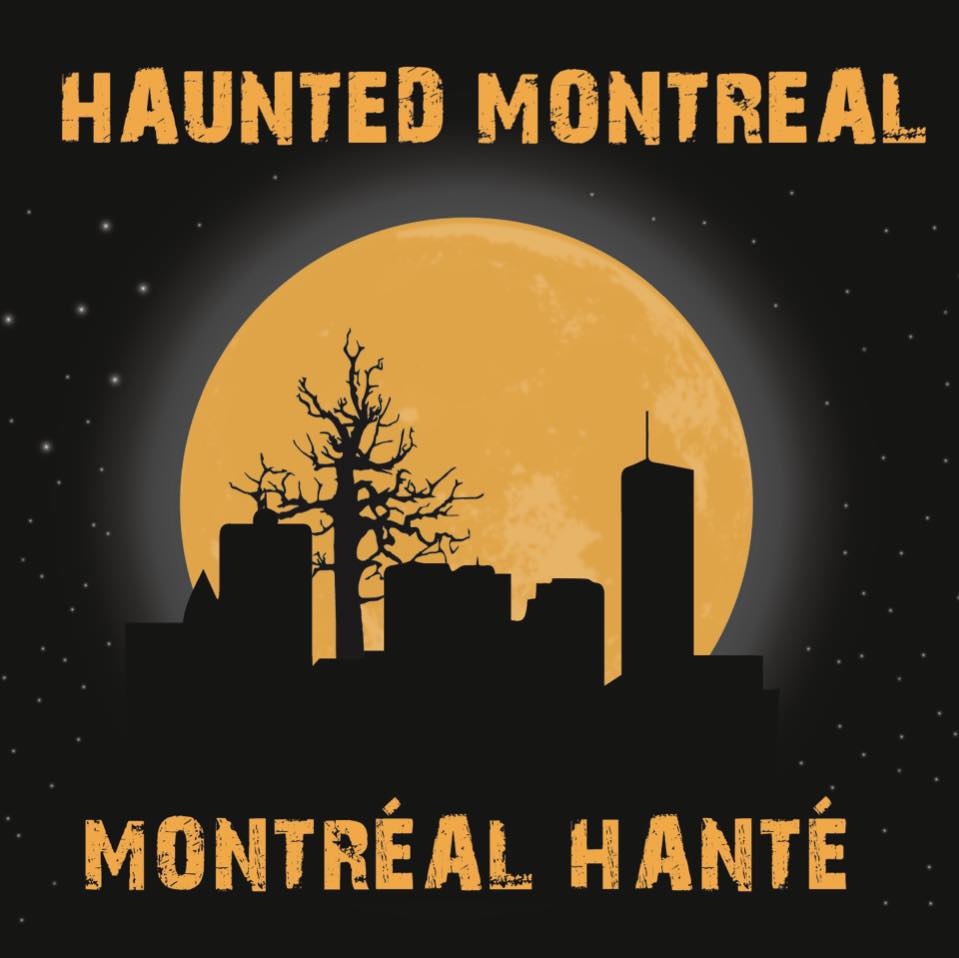
Haunted Montreal is now in winter mode and is not offering a season of outdoor public tours until the spring. The good news is that we are pleased to announce that the Haunted Montreal Pub Crawl runs year round on Sunday afternoons. We are also looking for an indoor haunted location for our new Paranormal Investigation. Lastly, our ghost walks can still be booked for private groups, including Haunted Griffintown and Haunted Downtown. Haunted Mountain is not available due to dangerous icy conditions on Otsirà:ke / Mount Royal until it melts in May.
Our February blog examines Notre-Dame-de-Bon-Secours Chapel and the persistent rumours that the oldest church in the city is also the most haunted.
Haunted Research
The Notre-Dame-de-Bon-Secours Chapel is both the city’s oldest church and, if paranormal experts are to be believed, one of the most haunted locations in Old Montreal. Also known as the Sailor’s Church, this quaint stone structure is topped with three statues including the magnificent Lady of the Harbour, flanked by two Angels of the Apocalypse.
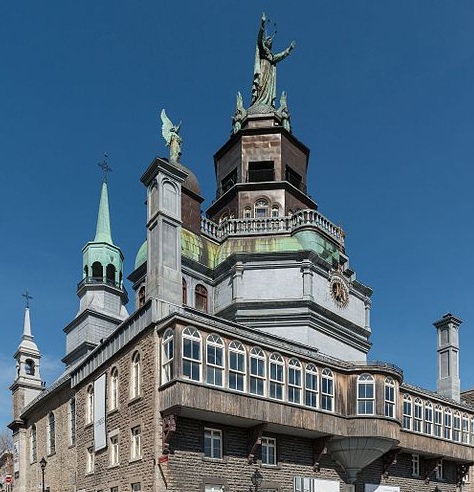
The church is shrouded in mystery. Not only are there the bodies of several nuns buried in the crypt, but it is also the location of Saint Marguerite Bourgeoy’s sacred remains, a miraculous statue, and a possibly haunted 1848 painting called “Le Typhus” by Theophile Hamel that depicts the gruesome impact of the Irish Famine on the city.
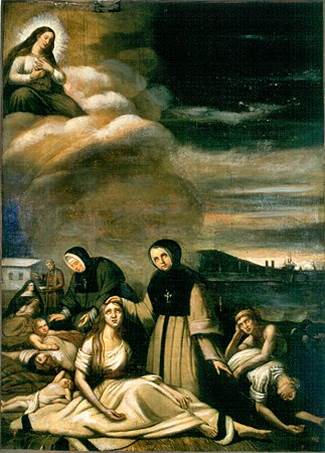
There are also several reports from tourists at having photographed either a man in a tuxedo or a priest from the outside of the church’s stained-glass windows. Some believe the ghost captured on film is none other than Famine priest M. Gottefrey, who suffered a terrible injury in the church hours before dying in the summer of 1847 while caring for Irish refugees.

To understand the significance of the church, it is important to look at some history. The island of Tio’tia:ke is part of the traditional territory of the Kanienʼkehá꞉ka or Mohawk First Nation. As part of European colonization, a French Catholic organization called “The Notre Dame Society of Montreal for the Conversion of the Savage Peoples of New France” established a colony called Ville-Marie on the island in 1642 when the Mohawk people were in their southern territory.

It wasn’t long before an all-out war broke between the French colonists and the Kanienʼkehá꞉ka First Nation, which lasted until 1701.
In 1652, colony leader Paul de Chomedey, Sieur de Maisonneuve, visited his sister in France and invited her colleague, Marguerite Bourgeoys, to join the colony as its first teacher.
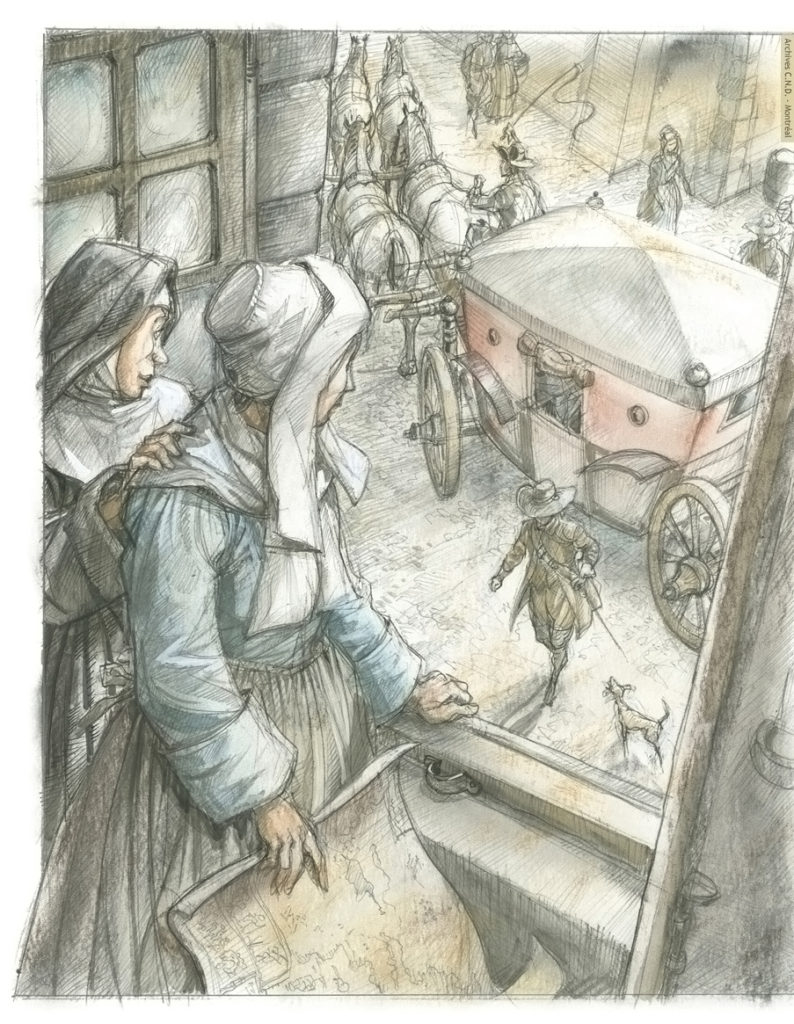
According to Bourgeoys:
“One morning, when I was fully awake, a tall woman dressed in a robe as of white serge, said to me clearly: “Go, I will never forsake you.” And I knew that it was the Blessed Virgin, although I did not see her face.”

Being a devout Catholic, she decided to join the colony where she was tasked with educating French children and “converting” Indigenous children to Catholicism. While today her “education” might well be considered cultural genocide against Indigenous people, in the mid-1600s, Catholic doctrine was almost ubiquitous in France and adherents believed that all non-Catholics were heathens in need of conversion.
It was a dangerous time for colonists to leave the palisaded settlement as the Kanienʼkehá꞉ka First Nation wanted their territory back and were willing to fight for it.

It was during this war that Marguerite Bourgeoys had the idea for the church.
In 1655, she rallied the colonists to build a chapel as a site of pilgrimage outside of the colony’s palisade, despite the danger. Before long, enough stones and materials had been collected to lay the foundation. However, in 1657, due to a change in ecclesial jurisdiction in the colony, the new Sulpician leaders suspended construction work for several years.
When the “The Notre Dame Society of Montreal for the Conversion of the Savage Peoples of New France” gifted her a stable to be used as a schoolhouse, Marguerite Bourgeoys kept herself busy with indoctrinating her students with Catholic ideology while also teaching them skills deemed useful for the colony.
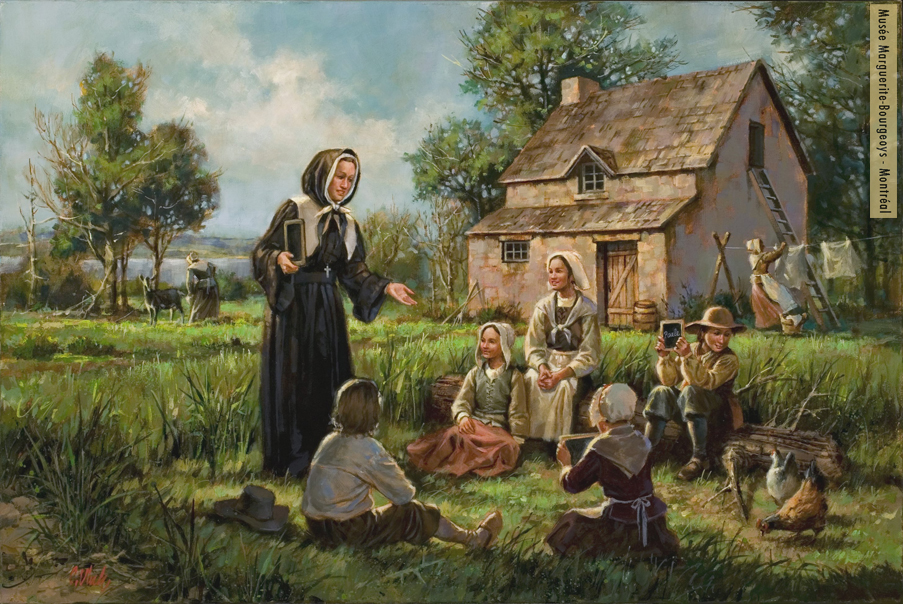
In in 1658, she founded the Congrégation de Notre Dame, a religious community for women that was not cloistered and which spent a considerable amount of time with “education”. They instructed not only the colony’s children and Les Filles du Roy (orphaned girls sent by the King of France to “populate the colony”), but also various Indigenous people, especially children.

The Congregation was directly associated with “The Notre Dame Society of Montreal for the Conversion of the Savage Peoples of New France”. The overall and feverish goal was to colonize and actively “civilize” the Indigenous people who had lived there for thousands of years by converting them to Catholicism. These religious zealots believed that they were “saviours”, and mainstream history has largely recorded them in this manner to the present day.
In 1676, with the help of the new Order of Sulpicians, Bourgeoys established a small school for Indigenous girls in a village located at the base of the mountain, known as the Mountain Mission.
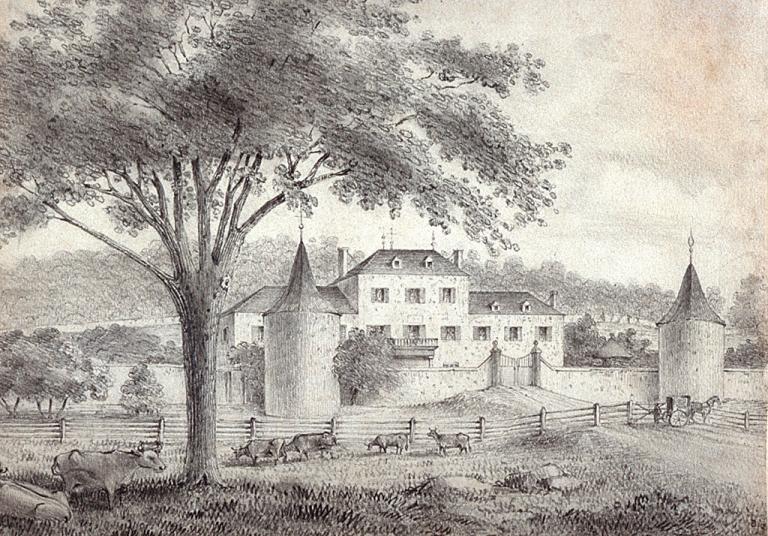
It’s effectiveness in evangelizing the students was seen as successful by the French. As a result, funding was granted to further her “educational” projects.
Marguerite Bourgeoys died in 1700, leaving a legacy of practical and religious “education” for French colonists – and cultural genocide against Indigenous peoples.

Following her death, the mission she founded moved from its location on the mountain to join with the Sulpicians at the Sault-au-Recollet.
For 20 years, the religious authorities continued their efforts to evangelize the children of the Nipissing, Kanienkehà:ka and Algonquin First Nations.

The mission would then move to Oka, in the area where Kanestetake exists today.
In 1678, the Notre-Dame-de-Bon-Secours Chapel was finally completed after numerous setbacks. A statuette that Marguerite Burgeoys had acquired in France of Our Lady of Perpetual Help was placed in the church as a religious relic.
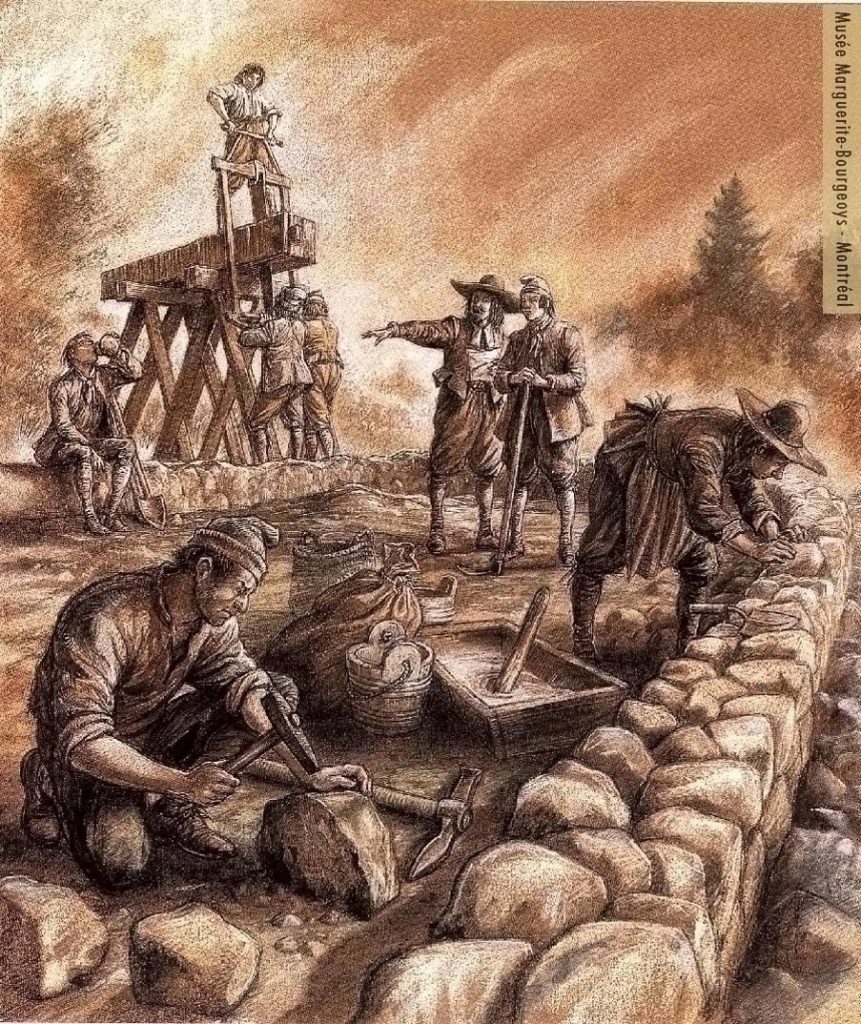
The chapel would continue to serve the community until a fire broke out in 1754, reducing it to a smoldering ruin.
The colonists claimed a miracle when the statuette acquired by Marguerite Bourgeoys was discovered in the ashes unscathed inside its reliquary.
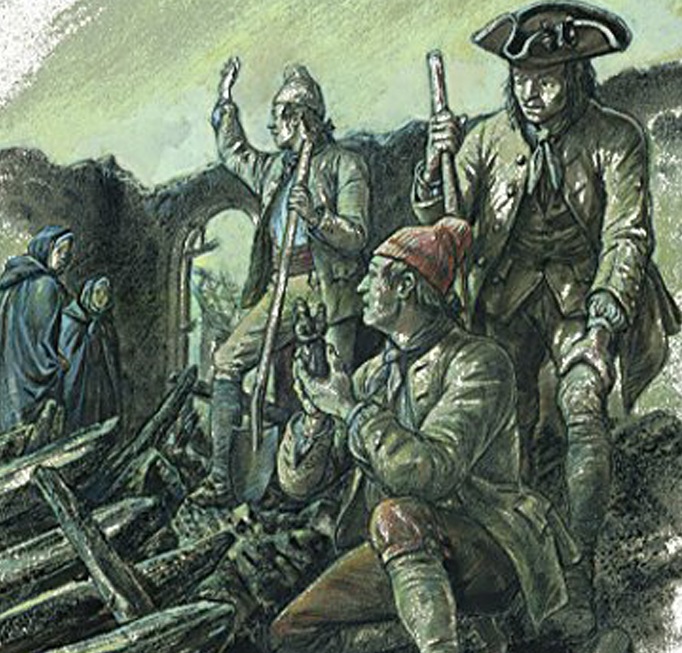
Just six years later, the city capitulated to British forces, who saw the site of the ruins as an ideal location to construct a barracks. The Sulpician priests intervened and persuaded British authorities that the chapel be rebuilt instead.
In 1771, a new church in the Norman-Gothic style was erected on the foundations of the old ruins and the “miraculous” reliquary and statuette were placed above the entrance on St. Paul Street. With the British in charge of new immigrants arriving from the United Kingdom, Irish and Scots Catholics soon began attending religious services in the church.

In 1831, the little statuette went missing and was presumed stolen along with its jewel-encrusted reliquary. In 1844, the statuette was discovered in one of the attics of the Mother House of the Congrégation de Notre-Dame.
Its reliquary was found in a dusty corner of the chapel 50 years later. It was only in 1988 that the statue was permanently returned to the chapel, now encased in a protective glass.
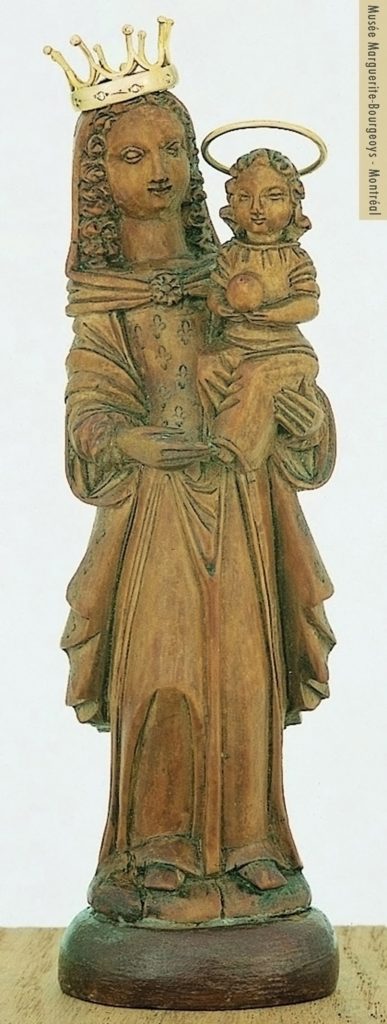
As the numbers of Irish immigrants rose dramatically, Sulpician authorities decided to build the new Saint Patrick’s Church, inaugurated in 1847. This was the same year that the Irish Famine devastated Montreal. Both Notre-Dame-de-Bon-Secours Chapel and Saint Patrick’s Church were instrumental in providing assistance of over 75,000 typhus-stricken Irish refugees. The shocking details can be read at the Haunted Montreal Blog about the Black Rock (issue 35).

Tragedy occurred on July 11, 1847, when a priest named M. Gottefrey had a terrible accident after tending to the Irish refugees in the fever sheds. According to the Annals of the Grey Nuns:
“On the 11th , M. GOTTEFREY, having to exercise his ministry at the convent, arrived in the evening, probably after returning from the SHEDS. A few of our sisters met him, he told them with his vivacious and joyous humour: “Courage, my dear sisters, the sufferings are short, but the reward is eternal.” In wishing goodnight to the superior whom he found very anxious and preoccupied with her patients, he said to her: “Take care to not kill yourself.” It was 6:30 in the evening. He directed himself towards the Church of Notre-Dame de Bonsecours to be given the Holy Sacrament which he wished to receive as the last rites. Reaching the third floor of the sacristy and wishing to open the door giving passage to a gallery, he forgot, perhaps, or he did not know most probably that we had got rid of this gallery, and since he had made a great effort to open this door which we had taken care to nail shut sufficiently, he rushed into a drop of more than THIRTY feet high. We transported him to the Hotel-Dieu, where it was not long before he expired and went to receive, the palm of the good servants always ready to immolate themselves in the service of the divine Master.”
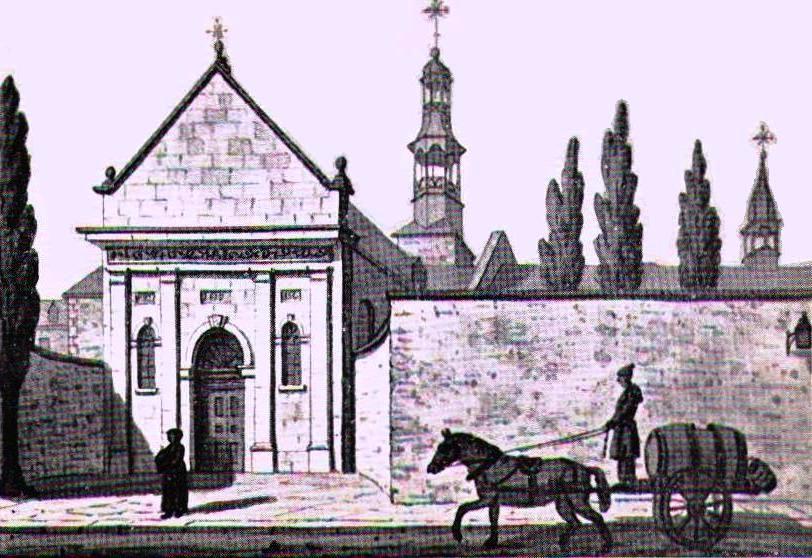
At the time, Bishop Bourget contracted typhus during the course of his duties and was nearing death. He prayed to the Virgin Mary for a divine intervention to save his life.
He promised that, if spared, he would restore the church as a pilgrimage site, create a new statue to adorn the church and commission a votive painting about the Church’s role during the Famine.

When the bishop survived the epidemic disease, he made good on his promises and commissioned Theophyle Hamel to paint “Le Typhus”, which was installed on the ceiling above the main entrance to the chapel, where it can still be seen today. It depicts the bishop and three orders of nuns tending to the typhus-stricken Irish famine refugees.
At least one American tourist believes the painting is haunted. Indeed, in late 2019, when looking up at the painting she witnessed something incredible. The tourist stated: “In the painting, the typhus victim of the dead man with the child clinging to him suddenly opened his eyes and stared directly at me! I was shocked! I grabbed my phone to snap a photo, but when I looked up his eyes were closed again. And no, I wasn’t taking advantage of Canada’s new legal marijuana laws, if that’s what you are thinking.”

Many tourists have reported paranormal activity within the church and its vicinity. On July 2, 2014, another visitor attending a ghost tour took some strange photos of the church and later wrote:
“While the tour guide was showing us around, I decided to capture moments and took pictures of the buildings and churches. One of the pictures was the Notre Dame De Bon Secours’s windows on the side of the building. I’ve shown the picture to my friends and we were wondering if one of the stained glass on the side of the building had an image of a man. I have attached here the photo and if you zoom in the 2nd window, you will see a man wearing a black tuxedo looking right back at the shooter. We just want to confirm if there really is an image of a man on the window.”
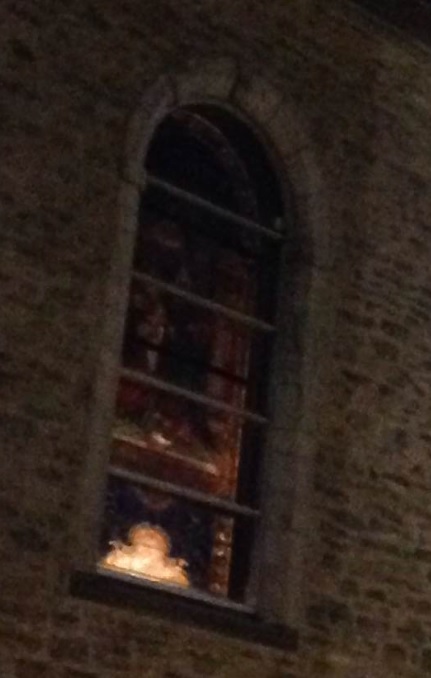
One paranormal expert believes the image is none other than the ghost of M. Gottefrey and that far from wearing a tuxedo, it is his ripped collar in the image, caused by his terrible plunge into the pews.
Another point of interest is the chapel’s maritime connection. It is also known as the “Sailor’s Church” because God-fearing seafarers would pray for safe crossings, trans-Atlantic or otherwise. Another of Bourget’s promises was to install a statue of the Virgin Mary, and in 1848 Charles Dauphin’s “Star of the Sea” was. This inspired a larger statue of The Lady of the Harbour on the rooftop in 1892. She faces the port, flanked by two Angels of the Apocalypse holding trumpets.
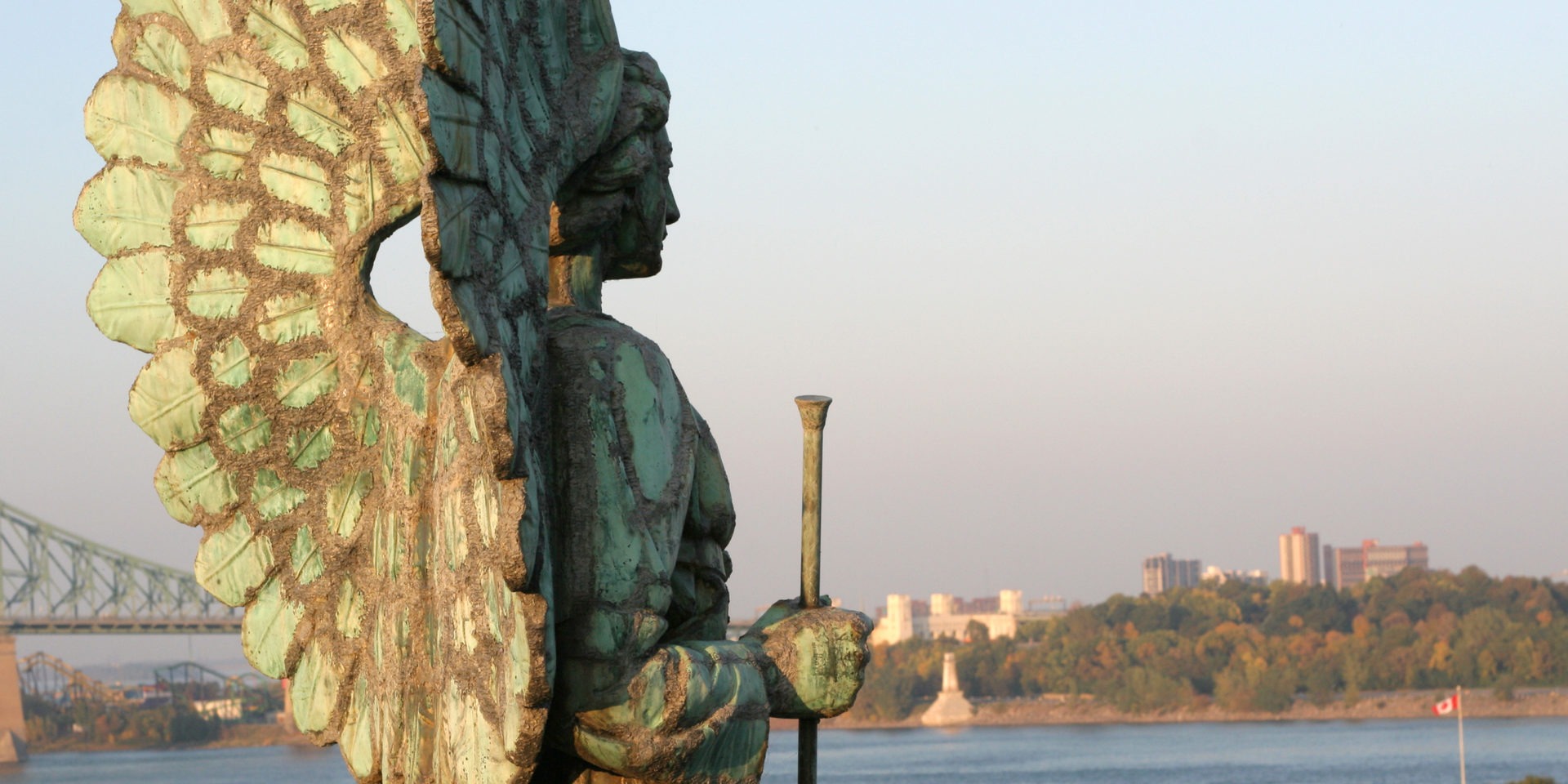
There is a fascinating Montreal legend about an apocalyptic and paranormal day when The Lady of the Harbour turned her back on the port, resulting in some serious tragedy. The story can be found in the Haunted Montreal Blog about the Phantom Calèche (issue 37).
Several miniature ex voto ships also hang from the chapel’s ceiling, gifts from thankful seafarers over the years.

Marguerite Bourgeoys became Canada’s first female Saint when she was Canonized on October 31, 1982. The Hallowe’en ceremony at Vatican City was presided by Pope John Paul II.
On the 350th anniversary of Marguerite Bourgeoys’ arrival in Montreal in 2003, celebrations marked the occasion. Two years later, the remains of Saint Marguerite Bourgeoys were placed in the left altar, below the statue of Notre-Dame-de-Bon-Secours. A few weeks after that, the remains of devout recluse Jeanne Le Ber were inserted into the east lateral wall of the chapel.
Le Ber is one of the city’s most devout personalities from the “New France” era. On June 24, 1685, then 18-year-old Le Ber took a simple vow of perpetual seclusion, chastity, and poverty.

Once a recluse, she spent long periods of time below a church altar when not self-flagellating, sewing or praying – right up until her death in 1714. Given her bizarre life of eternal seclusion and repentance, some paranormal experts believe that she too has returned as a spirit.
Today, visitors to the Notre-Dame-de-Bon-Secours Chapel can enjoy exploring the church in quietude and examining the exceptional relics, architecture and artworks. It costs nothing to enter.
For a fee, guests can explore the Margueritge Bourgeoys Museum to learn more of the history, climb up to the steeple for a panoramic view, and visit the creepy subterranean crypt.
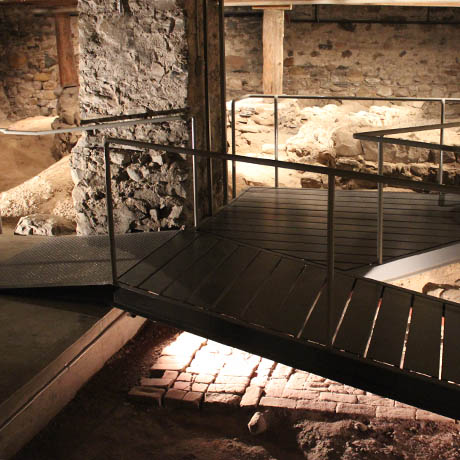
According to archaeologists, the bodies of several nuns lied buried beneath the crypt. Apparently, they were victims of an epidemic during the New France era and were buried below the first church. There is speculation that they too may haunt the chapel.
With all of the chapel’s storied history, statues, artworks, relics and various human remains, it’s no wonder that Montreal’s oldest church, Notre-Dame-de-Bon-Secours, is also reputed to be its most haunted!

Company News
Haunted Montreal is now in winter mode! For this first time ever, we will be operating year-round with our award-winning Haunted Pub Crawl, every Sunday afternoon.

Private tours are also available for Haunted Griffintown, Haunted Downtown, the Haunted Pub Crawl and our new Paranormal Investigation into the old Saint-Antoine Cemetery, weather-permitting for outside tours.
The Haunted Mountain Ghost Walk is not offered in the winter due to dangerous and icy conditions on the slopes.

Haunted Montreal would like to thank all of our clients who attended a ghost walk, haunted pub crawl or paranormal investigation during the 2019 – 2020 season!
If you enjoyed the experience, we encourage you to spread the word and to write a review on our Tripadvisor page, something that helps Haunted Montreal to market its tours.
Lastly, if you would like to receive the Haunted Montreal Blog on the 13th of every month, please sign up to our mailing list.
Coming up on March 13: Réseau Express Métropolitain’s Ghostly Gamble (Part 2)
The Réseau Express Métropolitain recently extracted over a dozen skeletons from the Black Rock Famine cemetery. Many of them were children who had succumbed to typhus. Tragically, they were buried in mass graves after crossing the Atlantic Ocean on “coffin ships”. The REM’s rationale for the exhumation was to install a concrete pylon for its upcoming $6.3 billion electric train network. This act prompted fears that ghosts of the Irish Famine Dead could easily haunt the system. Artists have already begun creating visuals depicting a paranormal station atop the pylon that serves as a disturbing connection between the living and the dead. Part 1 of the blog speculated about some of the ghosts who might infest the REM network. Part 2 offers Haunted Montreal’s innovative and inexpensive solution to try and protect the $6.3 billion electric train system from becoming haunted by Irish Famine ghosts and spirits.

Donovan King is a postcolonial historian, teacher, tour guide and professional actor. As the founder of Haunted Montreal, he combines his skills to create the best possible Montreal ghost stories, in both writing and theatrical performance. King holds a DEC (Professional Theatre Acting, John Abbott College), BFA (Drama-in-Education, Concordia), B.Ed (History and English Teaching, McGill), MFA (Theatre Studies, University of Calgary) and ACS (Montreal Tourist Guide, Institut de tourisme et d’hôtellerie du Québec). He is also a certified Montreal Destination Specialist.



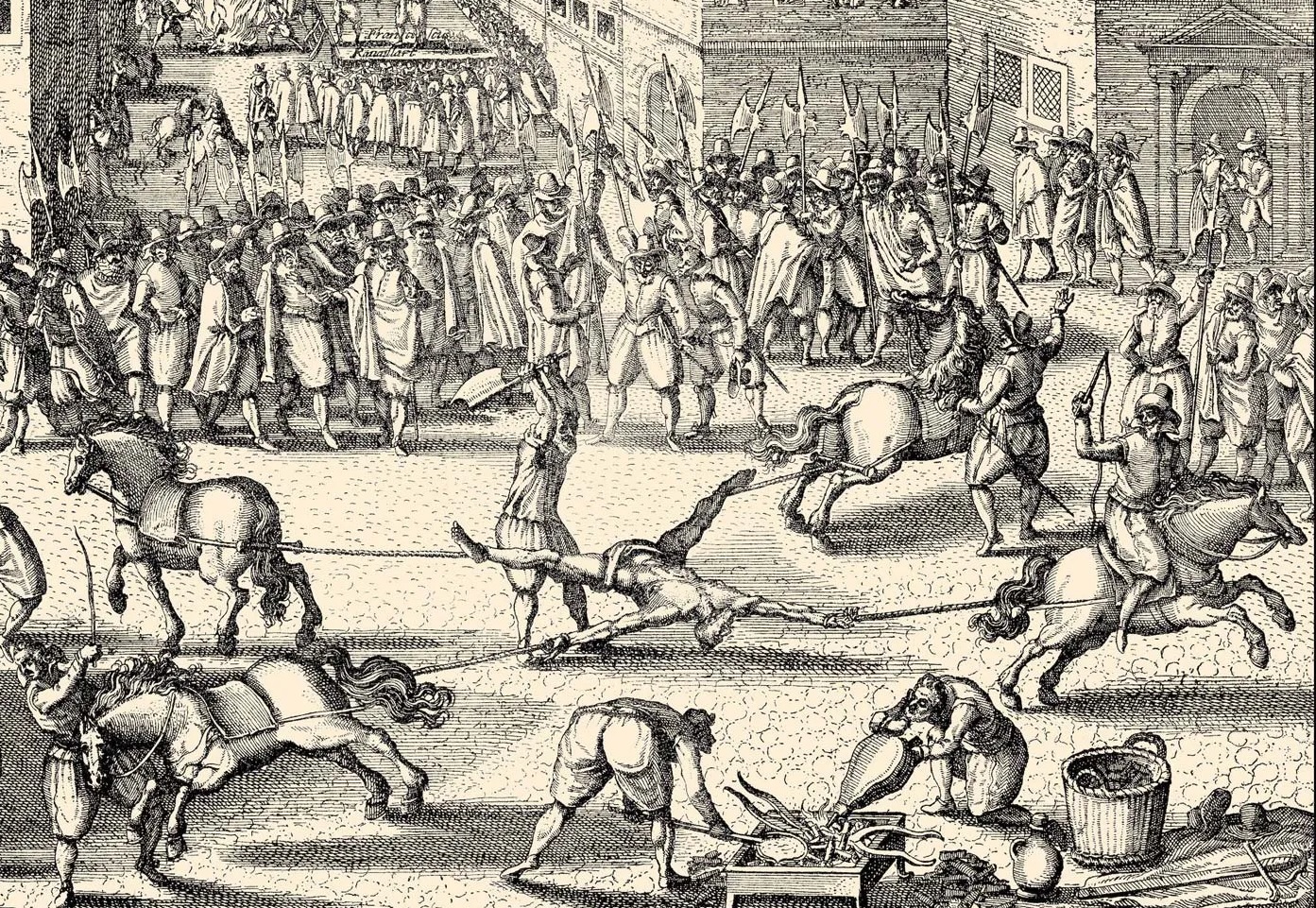
Comments (0)